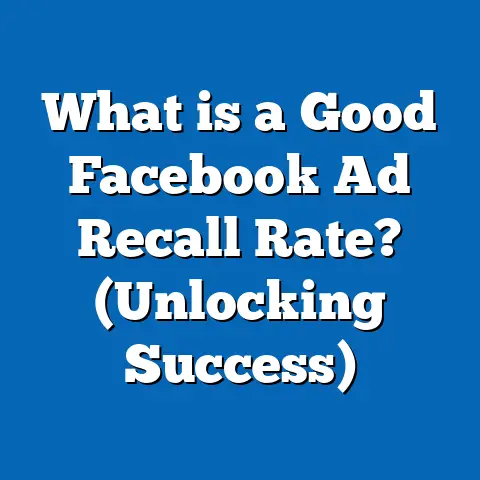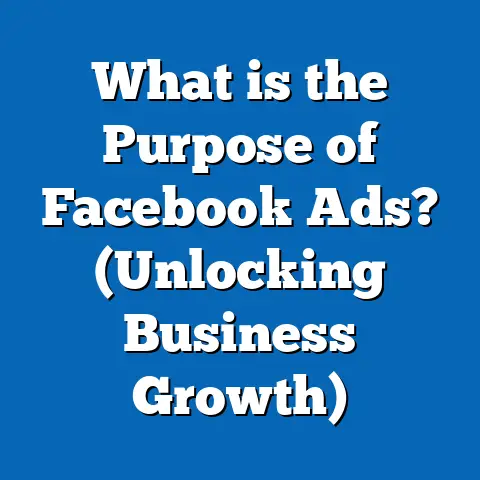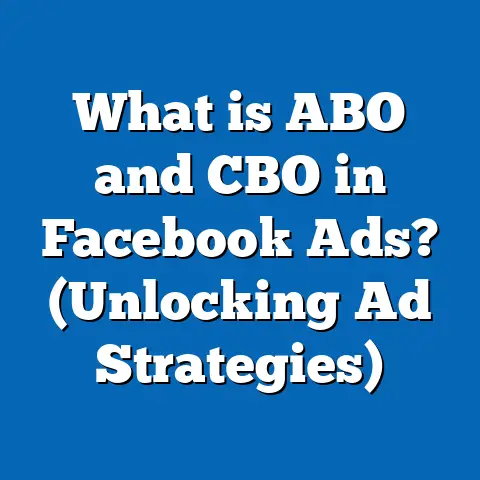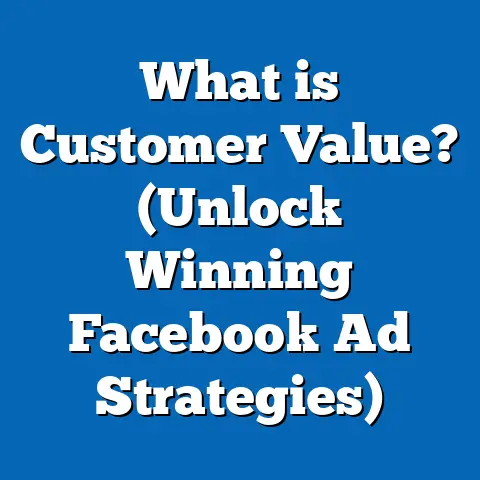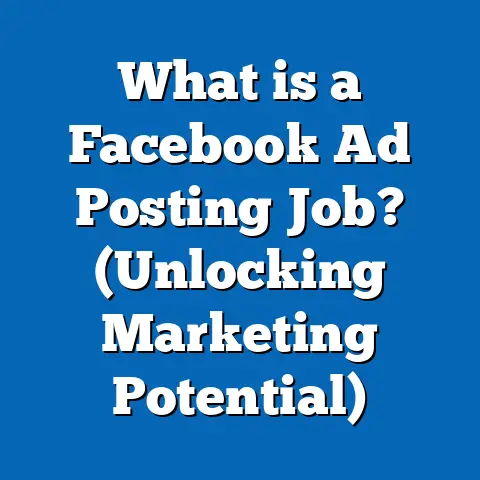What is a Good Facebook Ad Relevance Score? (Unlock Success!)
What is a Good Facebook Ad Relevance Score? (Unlock Success!)
Introduction: Why Facebook Ad Relevance Score Can Make or Break Your Campaign
In the fiercely competitive world of digital advertising, every cent spent on ads must deliver tangible results. Facebook remains the dominant platform for marketers because of its massive user base combined with laser-focused targeting capabilities. But launching your ads into the wild isn’t enough to guarantee success. Facebook’s algorithm evaluates your ads based on multiple factors to determine how relevant they are to your target audience. This evaluation directly impacts how often your ad is shown and how much you pay per engagement or conversion.
One of the most critical metrics that advertisers often overlook is the Facebook Ad Relevance Score—or its modern equivalents. This score acts as Facebook’s quality check on your ad’s resonance with your audience. Ignoring relevance metrics can lead to skyrocketing costs, lower ad delivery, and ultimately, poor campaign performance. Marketers who master this score unlock higher engagement rates, lower costs, and stronger campaign outcomes.
Understanding Facebook Ad Relevance Score: The Foundation of Effective Ads
What Was Facebook Ad Relevance Score?
The original Facebook Ad Relevance Score was a metric ranging from 1 (worst) to 10 (best), designed to measure how well your ad matched the interests and behaviors of your selected audience. Introduced to help advertisers optimize campaigns, it provided a quick snapshot of an ad’s potential effectiveness.
- How it worked: The score was calculated by weighing positive feedback signals (clicks, likes, shares, comments) against negative feedback (hiding or reporting the ad).
- What it influenced: Ads with higher relevance scores generally received better placement in news feeds and lower costs per click or conversion.
- Why it mattered: A high score meant Facebook saw your ad as valuable to users; a low score meant the opposite, leading to higher costs and restricted delivery.
Why Facebook Phased Out the Single Score
Though useful, the single relevance score was somewhat simplistic and didn’t give advertisers enough insight into why an ad performed well or poorly. In mid-2019, Facebook replaced it with three separate metrics that provide more detailed feedback:
- Quality Ranking
- Engagement Rate Ranking
- Conversion Rate Ranking
This change allows advertisers to better diagnose issues and optimize specific aspects of their campaigns.
The New Metrics Explained
Quality Ranking
This compares your ad’s perceived quality against ads competing for the same audience. It includes elements like:
- Ad content quality
- Landing page user experience
- Feedback such as spam reports or hidden ads
A high-quality ranking means users find your ad relevant and trustworthy.
Engagement Rate Ranking
This measures how your expected engagement rate compares with other ads targeting the same audience. Engagement includes:
- Likes
- Comments
- Shares
- Clicks
Higher rankings here indicate your ad generates more user interaction than competitors.
Conversion Rate Ranking
This predicts how likely your ad is to drive conversions compared to similar ads with the same campaign objective. Conversion might mean:
- Purchases
- Sign-ups
- Leads generated
A high conversion rate ranking means your ad is effective at driving desired actions.
Why Does Facebook Ad Relevance Matter? Data-Backed Evidence
The Cost Impact of Relevance Scores
Data from multiple studies and Facebook’s internal research clearly shows:
- Ads with above-average Quality Ranking can achieve up to 20-30% lower CPC.
- Improved Engagement Rate Ranking often leads to higher organic reach due to increased social proof.
- Better Conversion Rate Ranking can reduce cost per acquisition (CPA) by up to 25%.
For example, a WordStream study found that advertisers with relevance scores of 7 or higher saw CPCs nearly 50% lower than those with scores below 4 in campaigns before the metric was phased out.
Real-World Case Study: E-commerce Apparel Brand
An apparel brand targeting women aged 18–35 initially used stock product images leading to a Quality Ranking of “Below Average.” They switched to lifestyle images showing customers wearing clothes in everyday settings. Within 2 weeks:
- Quality Ranking improved to “Above Average”
- CPC dropped by 35%
- Sales increased by 20%
This highlights how creative quality directly influences relevance and costs.
Breaking Down How Facebook Calculates These Rankings
Understanding Facebook’s approach helps marketers optimize better.
Machine Learning at Work
Facebook’s algorithm analyzes numerous signals in real time:
- User engagement patterns (positive and negative)
- Competitor ads targeting the same audience
- Post-click experience on landing pages
- Historical ad performance data
The system continuously updates rankings as user behavior changes during the campaign.
User Feedback Signals
Negative signals like hiding ads or reporting them as spam weigh heavily. Even subtle cues like short video watch times or quick bounces from landing pages can reduce rankings.
How to Interpret Your Ad Relevance Metrics in Facebook Ads Manager
Where to Find These Rankings
In Facebook Ads Manager under individual ad sets or ads:
- Look for columns titled Quality Ranking, Engagement Rate Ranking, and Conversion Rate Ranking.
- Each will show “Above Average,” “Average,” or “Below Average.”
Diagnosing Problems
If any metric reads “Below Average”:
- Quality: Check creative clarity, image/video resolution, copy tone.
- Engagement: Test new calls-to-action or content formats.
- Conversion: Examine landing page relevance and load speeds.
Step-by-Step Guide to Improving Your Facebook Ad Relevance Scores
Step 1: Audience Targeting Precision
Use Facebook’s advanced targeting options:
- Custom Audiences from website visitors or customer lists
- Lookalike Audiences based on high-value customers
- Detailed interest and behavior targeting
More precise targeting ensures ads are shown only to those most likely interested.
Step 2: High-Quality Creatives That Resonate
Tips for creative excellence:
- Use high-resolution images/videos with clear focal points.
- Show products in use or real-life scenarios.
- Include branding subtly but clearly.
- Use engaging thumbnail images for videos.
Step 3: Copywriting That Connects
Effective copy should:
- Speak directly to pain points or desires.
- Be concise but informative.
- Include strong calls to action (e.g., “Shop Now,” “Get Your Free Trial”).
- Match tone and language preferences of target audience.
Step 4: Optimize Landing Pages for Conversion
Your landing page must:
- Load quickly (aim for under 3 seconds).
- Be mobile-friendly.
- Deliver on ad promises with clear product/service info.
- Have simple, visible call-to-action buttons.
Step 5: Test Constantly Using A/B Testing
Experiment with:
- Different images/videos
- Various headlines and descriptions
- Multiple audience segments
- Alternative offers/promotions
Pause low performers quickly, scale winners.
Advanced Strategies for Marketing Professionals
Leveraging Facebook Pixel Data for Deeper Insights
Install and configure Facebook Pixel properly to track:
- Page views
- Add-to-cart events
- Purchases or leads generated
Use this data for custom audience creation and conversion tracking which improves conversion rate ranking.
Dynamic Creative Ads
Facebook’s dynamic creative tool automatically tests multiple combinations of headlines, images, videos, and calls-to-action. The system then optimizes delivery toward best-performing variants—boosting engagement and conversions without manual guesswork.
Retargeting Strategies for Higher Conversion Rates
Create segmented retargeting campaigns aimed at users who:
- Visited product pages but didn’t buy
- Added items to cart but abandoned checkout
- Engaged with video ads but took no action
These warm audiences usually convert at higher rates, improving conversion rate rankings.
Common Mistakes That Hurt Your Relevance Scores and How to Avoid Them
| Mistake | Impact | How to Fix |
|---|---|---|
| Overly broad or untargeted ads | Low engagement & negative feedback | Refine targeting using custom/lookalike audiences |
| Using stale creatives | Declining quality ranking | Refresh creatives every 1–2 weeks |
| Ignoring negative feedback | Higher cost & limited reach | Monitor hide/report rates; adjust messaging |
| Driving traffic to poor landing pages | Higher bounce rate & low conversions | Optimize UX & speed; match ad copy promises |
| Neglecting mobile optimization | Poor user experience | Use responsive design & test on mobile devices |
Deep Dive Into Industry Trends Affecting Facebook Ad Relevance Scores
Privacy Changes Impact (iOS 14+ and Beyond)
Apple’s App Tracking Transparency framework limits data available for tracking users. This has forced marketers to:
- Rely more on engagement metrics than detailed conversion data.
- Focus on high-quality creatives and strong calls-to-action.
- Use aggregated event measurement tools provided by Facebook.
Video Content Dominance
Recent studies show video ads outperform static images in engagement by up to 35%, improving engagement rate rankings. Incorporate short-form videos, reels, or stories into your campaigns for better results.
AI-Powered Campaign Optimization
Facebook increasingly relies on AI to automate bidding and delivery based on predicted performance metrics. Advertisers who feed quality data through Pixel and engage in continuous testing benefit most from these algorithms.
In-depth Case Studies: Learning From Successes & Failures
Case Study 1: SaaS Company Boosting Lead Quality via Conversion Rate Ranking Optimization
A SaaS company targeting small business owners initially had a “Below Average” Conversion Rate Ranking despite good engagement. After analyzing landing page analytics, they realized their sign-up form was too long. By simplifying the form and clarifying the value proposition in ad copy, their ranking moved to “Above Average.” This led to:
- A 25% reduction in CPL
- 15% increase in qualified leads
- Better overall campaign ROI within one month
Case Study 2: Nonprofit Increasing Donations Through Engagement Rate Improvements
A nonprofit organization ran donation campaigns but faced low engagement rankings. They introduced storytelling videos featuring beneficiaries’ real stories rather than generic donation appeals. The result was:
- Engagement rate ranking improved from “Average” to “Above Average”
- Social shares increased by 50%
- Donations grew by 30% over two months
Comparing Facebook’s Relevance Metrics With Other Platforms: What Marketers Should Know
| Platform | Metric Name | Description | How It Affects Cost/Delivery |
|---|---|---|---|
| Quality/Engagement/Conversion Rankings | Multi-dimensional relevance scoring | Significant impact on CPC/CPA & reach | |
| Google Ads | Quality Score | Based on CTR, relevance & landing page experience | Directly influences CPC & ad rank |
| LinkedIn Ads | Relevance Score | User engagement & feedback | Influences cost & impression share |
| Twitter Ads | Quality Filter | Engagement & user feedback | Determines auction eligibility & cost |
Facebook’s split metrics provide more granular insights than LinkedIn’s single relevance score or Google’s composite Quality Score, allowing advertisers greater precision in optimization efforts.
Practical Checklist for Maintaining High Facebook Ad Relevance Scores
- Target Precisely: Use custom & lookalike audiences.
- Use High-quality visuals: Ensure images/videos are crisp and relevant.
- Write Clear Copy: Focus on benefits with compelling CTAs.
- Optimize Landing Pages: Fast loading & mobile-friendly.
- Monitor Feedback: Track hide/report stats regularly.
- Test Creatives Frequently: Refresh every couple of weeks.
- Use Pixel Data: Track conversions & retarget warm audiences.
- Leverage Dynamic Creative Ads: Automate optimization.
- Adapt To Trends: Incorporate video & privacy-compliant strategies.
- Review Rankings Daily: Adjust based on Quality, Engagement & Conversion insights.
Key Takeaways for Unlocking Success With Facebook Ad Relevance Scores
- Relevance scores directly impact your ad costs and delivery efficiency.
- Focus equally on creative quality, audience targeting, copywriting, and landing page experience.
- Use new Quality, Engagement, and Conversion rankings for deeper analysis than the old single relevance score allowed.
- Regular testing and iteration are essential for sustained success.
- Stay current with evolving platform policies, privacy changes, and content trends such as video dominance.
- Leverage data from Facebook Pixel and dynamic creative tools for smarter optimization.
Next Steps: Implementing What You’ve Learned Today
To unlock success with Facebook advertising relevance metrics:
- Audit all active campaigns for current quality, engagement, and conversion rankings.
- Identify low-ranking ads and prioritize refreshing creatives or refining targeting.
- Set up A/B tests focused on creative variables and audience segments.
- Review landing pages regularly for speed and message alignment.
- Install or optimize your Facebook Pixel setup for comprehensive tracking.
- Incorporate video content into your campaigns where possible.
- Monitor privacy updates closely and adjust strategies accordingly.
- Use insights gained from rankings daily to adjust bids, budgets, or creative assets dynamically.
Mastering these metrics ensures every dollar you spend reaches the right people with the right message at the right time—maximizing ROI in a competitive digital marketplace.
If you’d like help auditing your current campaigns or crafting high-relevance creatives tailored specifically for your audience, feel free to ask!

